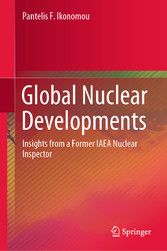Suchen und Finden
Service

Global Nuclear Developments - Insights from a Former IAEA Nuclear Inspector
Pantelis F. Ikonomou
Verlag Springer-Verlag, 2020
ISBN 9783030469979 , 194 Seiten
Format PDF, OL
Kopierschutz Wasserzeichen
Preface
7
Acknowledgements
9
Contents
11
Acronyms
16
1 Introduction
19
1.1 History, Science, Politics—Power and Primacy
19
1.2 Nuclear Fission and Nuclear Weapons—Intelligence and Absurdity
22
References
23
2 Facts and Institutions
24
2.1 Realities
24
2.2 Global Legal Framework
26
2.2.1 International Atomic Energy Agency—IAEA
26
2.2.2 Non-proliferation Treaty—NPT
26
2.2.3 Nuclear Weapon Free Zones—NWFZ
27
2.2.4 Comprehensive Nuclear-Test Ban Treaty—CTBT
28
2.2.5 Nuclear Suppliers Group—NSG
29
2.2.6 UNSC Resolution 1887/2009 on Nuclear Non-proliferation and Nuclear Disarmament
30
2.2.7 Treaty for the Prohibition of Nuclear Weapons—TPNW
30
2.2.8 Treaties, Conventions, Agreements, Resolutions
31
References
32
3 Capability, Threat, Response
33
3.1 Nuclear Capability
33
3.2 Nuclear Threat
34
3.3 Addressing the Nuclear Threat—The Three IAEA “S”
36
3.3.1 Nuclear Safeguards
37
3.3.2 Nuclear Safety and Security
38
Reference
39
4 Nuclear Crises
40
4.1 North Korea 1993–2020
41
4.1.1 History of the Crisis
41
4.2 Iraq 1991 and 2003
51
4.2.1 Personal Experience
51
4.2.2 Historical Events
52
4.3 Iran 2003–2015 and 2018–2020
55
4.3.1 History of Crisis
55
4.3.2 Consequences—Possible Developments
67
4.3.3 Comments
69
4.4 Syria 2011–2020
70
4.4.1 History of an Outstanding Issue
70
4.4.2 Consequences—Results
70
4.4.3 Comment
71
4.5 Libya 2003–2004
72
4.5.1 History
72
4.5.2 Consequences—Results
73
4.5.3 Comment
73
4.6 Romania 1978–1989
74
4.6.1 History
74
4.6.2 Concealed Nuclear Military Dimension
75
4.6.3 Comment
76
4.7 Former Soviet Union 1991–2000
76
4.7.1 New Nuclear Risks
76
4.7.2 Mission to the Nuclear Reactor Beloyarsk, 1986
77
4.7.3 Mission “Sapphire”—Kazakhstan, 1993
80
References
80
5 Nuclear Suitors or Would-be Proliferators
82
5.1 Turkey: Capable or Cunning Bluffer?
82
5.1.1 History—Planning
82
5.1.2 Akkuyu
83
5.1.3 Sinop
87
5.1.4 Igneada
88
5.1.5 International Support
89
5.1.6 Assessment of Turkey’s Nuclear Program
89
5.1.7 Perspective
90
5.1.8 Erdogan—Putin and Geopolitical Uncertainty
90
5.1.9 US Nuclear Weapons in Incirlik
93
5.1.10 Turkish Nuclear Bomb: Reality or Myth?
94
5.1.11 Comments and Conclusions
97
5.2 Saudi Arabia
99
5.3 Egypt
101
5.4 Japan
102
5.4.1 Peaceful Nuclear Energy Program
102
5.4.2 Possible Military Dimension
103
5.5 South Korea
104
5.5.1 Peaceful Nuclear Program
104
5.5.2 Possible Military Dimension
105
References
106
6 Nuclear Accidents—Nuclear Incidents
108
6.1 Nuclear Accidents—Safety
108
6.2 Nuclear Incidents—Security
111
References
117
7 NPT Nuclear Weapon States (NWS)
118
7.1 United States
118
7.1.1 History
118
7.1.2 Trump’s Doctrine and the Munich Security Conference
119
7.1.3 Global Concern and Uncertainty
121
7.1.4 The US and Nuclear Crises
123
7.2 Russia
127
7.2.1 History
127
7.2.2 Present
128
7.2.3 Future
129
7.3 China
131
7.3.1 History
131
7.3.2 Peaceful Nuclear Program
131
7.3.3 Military Nuclear Program
133
7.4 United Kingdom
133
7.4.1 History
133
7.4.2 Peaceful Nuclear Program
134
7.4.3 Military Nuclear Program
135
7.5 France
135
7.5.1 History
135
7.5.2 Peaceful Nuclear Program
135
7.5.3 Military Nuclear Program
136
7.6 Nuclear Weapons in Non-nuclear Weapon States
137
References
137
8 Non-NPT Nuclear Weapon States
138
8.1 India
138
8.1.1 Peaceful Nuclear Program
138
8.1.2 Military Nuclear Program
139
8.1.3 Future
140
8.2 Pakistan
141
8.2.1 Peaceful Nuclear Program
141
8.2.2 Military Nuclear Program
141
8.2.3 Future
144
8.3 North Korea (See also Sect. 4.1)
144
8.4 Israel
145
8.4.1 History
145
8.4.2 Present
148
8.4.3 Future
148
8.5 South Africa
149
8.5.1 History
149
8.5.2 Peaceful Nuclear Program
150
8.5.3 Nuclear Weapon Development
151
8.5.4 Twenty-Six Years Later
156
References
157
9 Observations, Conclusions, Perspective
158
9.1 Four Observations
158
9.1.1 Technical “Details”
158
9.1.2 A Prelude to Worrying Nuclear Developments
158
9.1.3 Common Characteristics of Nuclear Weapon Holders
159
9.1.4 Mutual Assistance Between Nuclear Weapon Holders
159
9.2 Three Conclusions
160
9.2.1 Safeguards After the AP
160
9.2.2 Shaking NPT
161
9.2.3 “Double Standards”
163
9.3 Gloomy Perspective—“Tetra-Polar” Balance
165
References
169
10 Correction to: Nuclear Suitors or Would-be Proliferators
171
Correction to: P. F. Ikonomou, Global Nuclear Developments, https://doi.org/10.1007/978-3-030-46997-9_5
171
Epilogue—Policy Proposal
172
References
180
Annex I Einstein’s Letter to the US President F. D. Roosevelt—1939
181
Annex II 2005-Nobel Peace Prize’s Political Message
183
Annex III Global Overview of Power Reactors and Nuclear Share
185
Annex IV Nuclear Power Reactors Under Construction
187
Annex V Status of Nuclear Arsenals (Warheads) in 2019
189
Annex VI World Enrichment Capacity—Operational and Planned (Thousand SWU/yr)
190
Annex VII International Nuclear and Radiological Event Scale (INES)
191
Index
192


